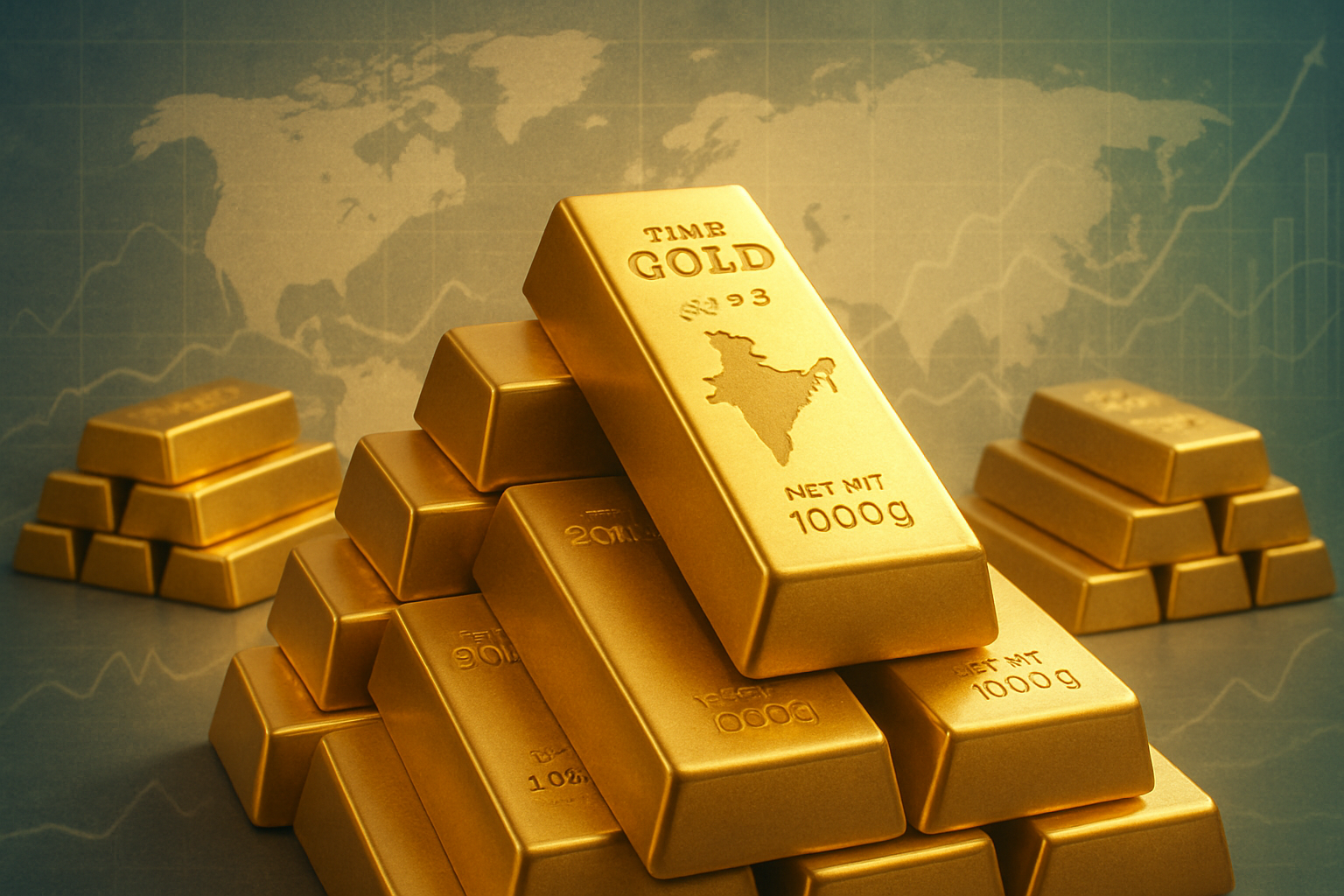
Mumbai, India – October 22, 2025 – The Reserve Bank of India (RBI) has achieved a significant milestone, with its gold reserves officially surpassing 880 metric tonnes, reaching 880.18 metric tonnes by the end of September 2025. This historic accumulation, valued at approximately $95 billion at the time and crossing the $100 billion mark by October 10, 2025, underscores a deliberate and strategic pivot by India's central bank towards diversifying its foreign exchange reserves. The move reflects a broader global trend among central banks to bolster their gold holdings amidst escalating economic uncertainties and geopolitical tensions, ultimately impacting global gold prices and fostering greater market stability.
This substantial increase in gold reserves, while partly driven by modest physical purchases, is predominantly a result of a remarkable surge in global gold prices throughout 2025. The RBI's measured approach to gold acquisition, coupled with the metal's role as a traditional safe-haven asset, positions India with enhanced financial resilience. The growing share of gold in the nation's foreign exchange reserves highlights a strategic effort to hedge against currency fluctuations and reduce dependency on traditional reserve assets like the US dollar, signaling a potentially transformative shift in international reserve management practices.
Detailed Coverage: A Deeper Look at RBI's Golden Strategy
The journey to 880.18 metric tonnes for the Reserve Bank of India's gold reserves by September 2025 represents a culmination of consistent, albeit varying, acquisition strategies. Following a substantial addition of 54.13 metric tonnes during the fiscal year 2024-25, the pace of physical gold purchases by the RBI slowed significantly in 2025. From January to September 2025, the central bank acquired only 4 tonnes of gold, a stark contrast to the 50 tonnes purchased during the same period in 2024. More specifically, in the first half of the 2025-26 fiscal year (April-September), only 0.6 metric tonnes were added, with 0.4 metric tonnes in June and 0.2 metric tonnes in the final week of September.
Despite the slower physical buying, the total value of India's gold reserves soared past the $100 billion threshold for the first time by October 10, 2025, reaching $102.365 billion. This phenomenal increase was primarily fueled by an extraordinary global rally in gold prices, which appreciated by approximately 65% throughout 2025. These significant valuation gains on existing holdings have been the main driver behind the record-breaking value, rather than aggressive new purchases in the current year. The share of gold in India's total foreign exchange reserves has concurrently climbed to 14.7% by October 10, 2025, marking its highest proportion since 1996-97 and underscoring a deliberate strategy to diversify assets.
The RBI's actions are not isolated; they are part of a broader global trend of central bank gold accumulation. Key players in this global phenomenon include the People's Bank of China, which continues to be a major purchaser, holding 2,264 tonnes as of June 2025 (though actual figures may be higher). The National Bank of Poland has aggressively increased its holdings to 359.9 tonnes by the end of 2024 and aims for 30% gold share in its reserves. Other notable accumulators include the Central Bank of the Republic of Turkey (590 tonnes by Dec 2024), the National Bank of Kazakhstan, the Czech National Bank, and the Monetary Authority of Singapore. Collectively, central banks worldwide added 166 tonnes to their official reserves in the first half of 2025-26, driven by a desire to reduce US dollar dependency and hedge against inflation and geopolitical risks.
Initial market reactions to the RBI's gold holdings surpassing 880 tonnes, particularly coinciding with the $100 billion valuation, have been largely positive. Financial analysts and industry experts view this as a strategic and prudent move, enhancing India's financial stability and providing a robust buffer against potential global economic volatility. RBI Governor Sanjay Malhotra reportedly highlighted that the robust gold rally has significantly strengthened India's reserves, which now cover an impressive 11 months of imports. Domestically, the global rally has pushed gold prices in India to an all-time high of ₹1,33,175 per 10 grams (24K) on Dhanteras, with spot gold prices globally breaching $4,300 per ounce in mid-October, reflecting strong safe-haven demand.
Companies That Might Win or Lose from This Golden Shift
The Reserve Bank of India's increasing gold holdings, and the broader trend of central bank gold accumulation, create significant ripples across various sectors, impacting public companies both directly and indirectly. The sustained demand for gold from sovereign entities, coupled with soaring global prices, sets the stage for distinct winners and potential losers.
Potential Winners:
- Gold Mining Companies: Companies involved in gold extraction are direct beneficiaries. Increased demand and higher prices translate directly into fatter profit margins and stronger revenue streams. Major global players like Barrick Gold (NYSE: GOLD) and Newmont (NYSE: NEM), with their extensive mining operations, stand to gain substantially from a sustained bullish gold market. Smaller and mid-tier miners also see improved prospects, potentially leading to increased exploration budgets and production expansions.
- Gold-Backed Exchange Traded Funds (ETFs) and Investment Vehicles: Products like the SPDR Gold Shares (NYSEARCA: GLD), which directly track gold prices, experience increased investor interest as gold's appeal as a safe haven and store of value grows. Central bank activity legitimizes gold as a core asset, attracting more institutional and retail investors to these accessible investment vehicles.
- Refiners and Dealers of Physical Gold: Companies involved in refining, assaying, and distributing physical gold, such as those supplying central banks or facilitating large-scale bullion transactions, will likely see increased business volumes.
- Indian Financial Institutions: While not directly gold-related, increased stability in India's foreign exchange reserves due to gold holdings can indirectly benefit Indian banks and financial institutions by fostering a more stable economic environment, reducing currency risks, and potentially improving sovereign credit ratings. This could lead to lower borrowing costs and increased investor confidence in the Indian financial system.
Potential Losers:
- Companies with Significant Exposure to US Dollar-Denominated Assets: As central banks, including the RBI, diversify away from the US dollar, demand for dollar-denominated bonds and other assets could soften in the long term. Companies heavily invested in or reliant on these assets might face challenges if the dollar's global dominance begins to erode, though this is a long-term and complex shift.
- Certain Fiat Currency-Focused Investment Strategies: Investment funds or strategies that heavily bet against gold or rely solely on the stability of specific fiat currencies without diversification could underperform in an environment where gold is increasingly seen as a preferred reserve asset.
- Inflation-Sensitive Companies (in some scenarios): While gold is an inflation hedge, if the underlying reasons for central banks buying gold (e.g., inflation concerns, de-dollarization) lead to significant currency instability or inflation, companies that struggle to pass on increased costs or whose business models are highly sensitive to currency fluctuations could face headwinds. However, this is a more indirect and speculative impact.
The overall sentiment suggests that the strategic shift by central banks towards gold accumulation is a net positive for the gold industry and its related financial products, while potentially posing long-term strategic questions for those heavily invested in traditional reserve assets.
Wider Significance: Reshaping Global Financial Dynamics
The Reserve Bank of India's substantial gold accumulation, now exceeding 880 tonnes, is far more than an isolated financial event; it is a critical indicator of profound shifts in global financial dynamics. This move by the RBI fits squarely into a broader and accelerating trend among central banks worldwide to increase their gold reserves, driven by a confluence of economic uncertainties, heightened geopolitical tensions, and a strategic desire to diversify away from traditional reserve assets, particularly the US dollar.
This ongoing gold buying spree by central banks, which saw over 1,000 tonnes added globally in both 2023 and 2024, and another 166 tonnes in the first half of 2025-26, signifies a collective re-evaluation of reserve management strategies. The motivations are clear: gold acts as a reliable hedge against inflation, offers stability during currency volatility, and serves as an independent asset in an increasingly fragmented global political landscape. The RBI's increasing share of gold in its foreign exchange reserves, now at 14.7%, is a testament to this strategic realignment, aiming to build a more resilient and diversified portfolio.
The potential ripple effects on competitors and partners are substantial. As more central banks embrace gold, the demand for the precious metal is likely to remain robust, supporting higher price levels. This sustained demand could put pressure on the US dollar's status as the world's primary reserve currency in the long run, affecting countries that hold vast dollar reserves. For emerging economies, a strong gold reserve provides a credible signal of financial strength and independence, potentially enhancing their geopolitical leverage and reducing their vulnerability to external economic shocks.
Regulatory and policy implications are also significant. The RBI's actions reflect a proactive monetary policy aimed at safeguarding national economic interests. It implies a reduced reliance on foreign currency interventions to manage exchange rates and a greater emphasis on domestic financial stability. Historically, central banks have turned to gold during periods of global instability, such as the post-Bretton Woods era or during major financial crises. The current accumulation parallels these historical precedents, suggesting a profound lack of confidence in the existing international monetary architecture and a return to gold's enduring role as a universal store of value. This trend could also spur other nations to re-evaluate their own reserve compositions, creating a domino effect across global financial markets.
What Comes Next: Navigating the Golden Horizon
The RBI's strategic embrace of gold, mirrored by central banks globally, sets the stage for a dynamic period in financial markets. Understanding the short-term and long-term possibilities is crucial for stakeholders.
In the short-term, we can anticipate continued robust demand for gold from central banks. This sustained buying pressure, even if at a slower physical pace for some like the RBI (as valuation gains drive much of the recent value increase), is likely to keep global gold prices buoyant. Investors should watch for further announcements from central banks regarding their reserve compositions, as any acceleration in gold accumulation could further fuel price rallies. The heightened geopolitical tensions and persistent inflation concerns are expected to maintain gold's appeal as a safe-haven asset, potentially leading to continued volatility in other asset classes, which would further bolster gold's relative attractiveness.
Long-term possibilities point towards a gradual but significant recalibration of the international monetary system. A sustained trend of de-dollarization, with central banks diversifying away from the US dollar, could lead to a more multi-polar reserve currency landscape. This shift would have profound implications for global trade, capital flows, and the geopolitical influence of nations. For India, a larger gold reserve enhances its financial sovereignty and provides greater flexibility in navigating global economic headwinds. It could also strengthen the rupee's stability in the long run by providing a credible backing to the national currency.
Potential strategic pivots or adaptations will be required from various market participants. Governments might explore new bilateral trade agreements denominated in non-dollar currencies or backed by gold. Corporations with significant international operations may need to re-evaluate their currency hedging strategies and diversify their treasury holdings. For individual investors, the increasing role of gold suggests a need to consider it as a core component of a diversified portfolio, rather than merely a speculative asset.
Market opportunities or challenges that may emerge include the growth of gold-backed financial products and services, as well as increased demand for gold mining and refining capabilities. Challenges could arise for countries heavily reliant on the US dollar for their reserve management, potentially necessitating a re-evaluation of their own economic policies. Potential scenarios and outcomes range from a steady evolution towards a more diversified global reserve system to more disruptive shifts if geopolitical events accelerate the de-dollarization trend. A key outcome is the strengthening of gold's role as a foundational asset in the global financial architecture.
Wrap-Up: India's Golden Future and Global Implications
The Reserve Bank of India's gold holdings crossing the 880-tonne mark, with its value soaring past $100 billion, marks a pivotal moment in India's financial history and a significant development in global financial markets. The key takeaway is the RBI's strategic commitment to diversifying its foreign exchange reserves, enhancing national financial stability, and hedging against the volatilities of the international economic landscape. While recent physical gold purchases have been modest, the dramatic increase in the value of these reserves, largely driven by a robust 65% surge in global gold prices in 2025, underscores gold's enduring appeal as a safe-haven asset.
Moving forward, the market is poised for continued interest in gold, fueled by persistent global economic uncertainties, geopolitical tensions, and the collective actions of central banks seeking to de-risk their portfolios. This trend suggests a potential long-term shift away from an over-reliance on a single reserve currency, paving the way for a more diversified and resilient international monetary system. India's proactive stance, mirroring that of other major central banks, reinforces gold's role as a cornerstone of national wealth and stability.
Investors should closely watch several factors in the coming months. These include further central bank gold purchase announcements, global inflation data, and any escalation or de-escalation of geopolitical conflicts, all of which will influence gold prices. The performance of the US dollar and other major fiat currencies will also be critical indicators of the pace and direction of reserve diversification. The RBI's golden milestone is not just a testament to India's growing economic prudence but also a clear signal of a transforming global financial order, where gold is reclaiming its ancient, yet ever-relevant, mantle as the ultimate store of value.
This content is intended for informational purposes only and is not financial advice




